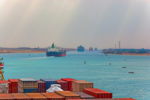
Think Tank
Do Special Economic Zones Benefit Women?

Photo: iStock.com/FangXiaNuo
For decades, it has been widely reported by international development organizations such as UNCTAD and the World Bank that women account for between 60% and 70% of the workforce in special economic zones worldwide.
But are these claims true? And even if they are, do SEZs actually benefit the advancement of women? What implications does this have on the development of future economic zones?
SEZs are business parks or cities that have been granted exemptions from most national-level economic regulations. They often enjoy tax breaks, different labor laws, special visa rights, import and export exemptions, and streamlined regulations. There are more than 7,500 SEZs in 100 countries worldwide.
Some SEZs have fulfilled the World Bank’s promise of female empowerment. But many have precisely the opposite effect.
Major questions about women’s rights as they pertain to SEZs have been raised recently as news has spread of dozens of women being freed from forced prostitution in the Golden Triangle SEZ in Laos. Chinese women were lured into the zone to serve as telemarketers for the Kings Romans Casino. When they failed to meet their sales quota, their employers declared that they were “indebted” to the casino. The casino then forced several of them into prostitution to repay their debts. On January 18, 2022, eight women escaped, and petitioned authorities for help. In February, Laotian police raided the casino, freeing several other women. Laotian authorities are now asserting that there are more women being held captive, but without any formal complaints, they are unable to interfere.
It's important to note that the Golden Triangle SEZ is an extreme exception — it has the reputation of being, by far, the worst SEZ in the world. But to what degree do SEZs support or detract from women’s rights?
The news of the Golden Triangle SEZ came only months after yet another shocking blow: In one survey, 90% of female garment workers in Sri Lanka SEZs self-reported being sexually assaulted by male management.
For decades, the international consensus has been that SEZs play a major role in the advancement of the condition of women in emerging markets. Many zones have a reputation for being safe places where women can earn income in relatively high-paying jobs.
A December 2005 study published by the Korea Labor Institute describes how SEZs “became an important avenue for young women to enter the formal economy at better wages than in agriculture and domestic service. Women make up the majority of workers in the vast majority of zones, reaching up to 90% in some of them.”
The Korean study also found that Korean zones were very safe for women. According to the 2007 study commissioned by the Indian Council for Research on International Economic Relations, “Women dominate the workforce in SEZs in most developing countries. For instance, in the Philippines the share of women workers in the total SEZ workforce was 74% in 1980. It remained the same in 1994. In Korea, it was 70% in 1990. In Mexico, it was as high as 77.4% in 1981; it declined to 60% by 1993. In the Dominican Republic, it was 60% in 1995. In Bangladesh and Sri Lanka, it has been above 70%.”
The study goes on to explain how many surveys over the decades have found that SEZ wages are the main source of income for a significant percentage of women working there, and that they stabilize the lives of widows and single-mothers.
When trying to explain why so many women worked in SEZs, the study explained that women workers were considered “more disciplined and hard-working,” and that “employers prefer female workers to male workers in the belief that manual dexterity, greater discipline and patience make women more suitable for the unskilled and semi-skilled activities carried out in the zones. Besides, they are less likely to exert pressure for high wages and better working conditions.”
Already cracks were beginning to show. The Indian study cited findings that female workers in SEZs are typically 20 to 25 years old with poor bargaining power, and thus often subject to exploitation. “Employment generation in the zones therefore does not empower them.”
There also were concerns that hiring large numbers of women in traditional societies might have unintended economic consequences, by failing to reduce the local unemployment rate because the women in question were not previously part of the labor force.
In the decade and a half since 2007, academic literature has become significantly more critical of the benefits conferred by SEZs to women’s rights. An October 2018 report by the International Institute for Environment and Development found that “outright discrimination” existed in many workplaces, “particularly where women have insecure and low-status jobs that involve repetitive tasks, excessive overtime, occupational health and safety risks, and limited career development opportunities.” In addition, SEZs in Fiji and parts of Latin America have been accused of engaging in sexual harassment of women.
There are thousands of zones worldwide, and the overwhelming majority are completely safe for women. But it’s the outliers that cause problems and get the most attention.
Many of the world’s largest SEZs are run by, promoted by, and employ women. Nearly all SEZs pay lip service to women’s rights. The problem is that the zones that feature prominently at global conferences and on the internet aren’t the ones with human rights issues. The “problem SEZs” tend to keep quiet, lest they call unwanted attention to themselves.
SEZs tend to reflect the countries that host them, and the experiences of women vary widely. In Switzerland and Russia, SEZ upper management is dominated by women. Elsewhere, in South Korea or Colombia, they are safe places where thousands of female employees can economically advance. In Sri Lanka and Laos, they are centers of exploitation and unimaginable suffering.
Companies need to conduct more due diligence before moving to SEZs. Failure to do so makes them complicit in the system of exploitation. Major SEZ trade organizations like the African Economic Zones Organization, Free Zone Association of the Americas and World Free Zones Organization need to do a better job of condemning zones that do not elevate the condition of women, calling them out by name. Consultants need to refuse to work with exploitative zones.
SEZs provide economic opportunity to millions of impoverished women in emerging markets. Blanketly condemning them is counterproductive for the advancement of women. Instead, a policy of perpetual vigilance is required.
Katarina Serlet is chief executive officer, and Thibault Serlet is a special economic zone and free trade zone consultant, at the Adrianople Group.






